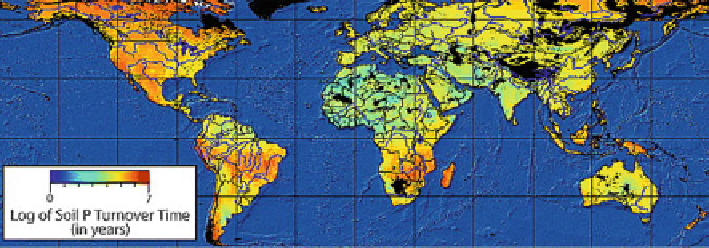Geoscience Reference
In-Depth Information
Fig. 14.3
Terrestrial soil phosphorus turnover times; shorter times mean a greater relative
importance of atmospheric supply relative to soil reservoir note timescales to millions of years
(Okin et al.
2004
)
of P, K, Ca and Mg may be large compared to loss rates of these nutrients for many
tropical rainforest systems, and hence, that dust inputs may be an important control
on productivity and carbon cycling. Houlton et al. (
2008
) demonstrate that nitrogen
fixation is very important in tropical forests and limited by phosphorus supply, while
outside of the tropics, nitrogen fixation is limited by temperature.
As noted earlier, most analyses of nutrient budgets focus on forest systems, but
Soderberg and Compton (
2007
) suggest that atmospheric deposition of dust is a very
important source of Al, Si, Ca and P in the Fynbos ecosystem developed on nutrient-
poor sandy spoils in the Cape region of South Africa, so the potential importance of
atmospheric P deposition associated with dust is not limited to tropical rainforests.
Okin et al. (
2004
) attempted a global evaluation of the significance of atmo-
spheric dust P supply based on an estimate of P associated with desert dust and
the global pattern of soil P. They expressed the results as a pseudo turnover time
for phosphorus, defined as the inventory of P in the top 20 cm of soil divided by
the estimated atmospheric input. This pseudo turnover time ranged from 10
2
to
10
7
years in different regions of the world, and a shorter turnover time equates to
increasing importance of atmospheric P supply in sustaining the soil P reservoir,
which they note to be “an important nutrient that is often limiting in terrestrial
environments”. The results are shown in Fig.
14.3
and indicate that dust deposition
of P is relatively more important for soil P supply in Europe, North and Central
Africa and Southern Asia compared to other regions. Menge et al. (
2012
) developed
an ecosystem model and use this to estimate that an atmospheric P supply associated
with dust of 0.1 kg ha
1
year
1
is sufficient to avoid P limitation. A comparison of
this threshold to the global modelled P deposition (Mahowald et al.
2008
) suggests
that quite large areas of tropical forests receive atmospheric P supply below this
threshold and so are potentially vulnerable to long-term P limitation.
Terrestrial carbon cycle models which include P have recently been developed
(e.g. Wang et al.
2010
;Golletal.
2012
) allowing the relative controls on productivity
to be estimated, although none that we know of have currently attempted to directly
quantify the impacts of atmospheric dust deposition. The results of one such

Search WWH ::

Custom Search